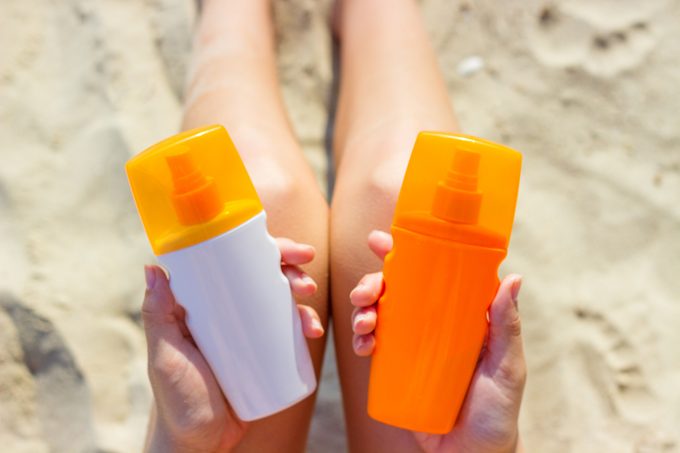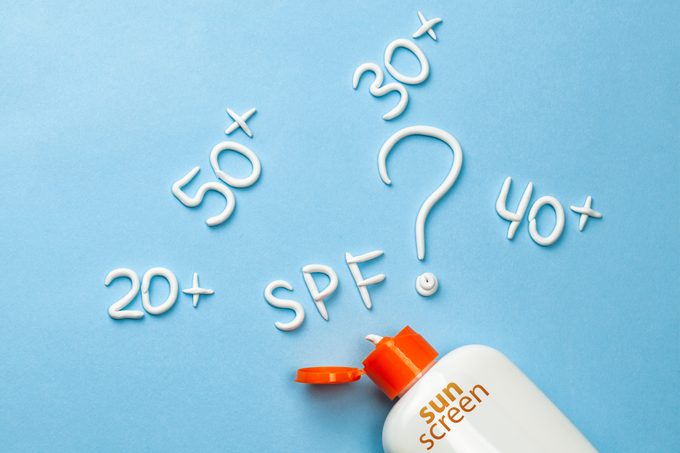What’s the Difference Between Sunscreen and Sunblock?
Updated: Apr. 20, 2021
Protecting your skin from the sun's harmful rays is the best way to reduce your risk of skin cancer and aging. But there's a lot to consider when choosing the best product for you. Skin care experts break down sunscreen vs. sunblock.
Skin care experts agree that the best form of sun protection is the kind that you will use every day—no exceptions. Hands down, this is the number one way to protect your skin from the damaging effects of the sun’s ultraviolet rays.
But here’s the dilemma: What type is best for you? A sunblock? A sunscreen? What SPF is enough? Should you choose a gel, cream, or lotion? We talk to experts who can help you decide.

The sun’s damaging light
The sun’s ultraviolet radiation comes in three main forms:
- UVA rays, which have the longest wavelengths and can penetrate to the middle layer of your skin;
- UVB rays, shorter waves than UVA, and absorbed to some degree by the ozone layer of the Earth’s atmosphere; UVB rays penetrate only the outer layer of your skin.
- UVC rays, the shortest wavelengths, which in nature are all absorbed by the ozone layer but also can be created by older tanning beds and some tools like welding torches.
Sunblock vs. sunscreen
These terms are often used interchangeably, but they shouldn’t be, says Laura Ferris, MD, PhD, associate professor of dermatology at the University of Pittsburgh School of Medicine.
“Sunblocks block UV radiation and reflect it back, while sunscreens chemically inactivate the energy of the UV light so it can’t damage your skin,” she says. Put another way, chemical sunscreens protect by altering the UV rays, while sunblocks physically shield you from the sun.
Chemical sunscreens
Chemical sunscreens in the U.S. can contain active ingredients such as ensulizole, octisalate, homosalate, octocrylene, octinoxate, oxybenzone, and avobenzone, according to the American Academy of Dermatology (AAD). The FDA is calling for more information on the safety of these ingredients, which is not to say they are dangerous, just that more evidence is needed. The agency also says it’s OK to keep using products with these ingredients.
Two studies from the FDA suggest that we can absorb chemicals in sunscreen into the bloodstream at levels greater than current safety thresholds. The second study was a follow-up to the first and was published in the January 2020 issue of the Journal of the American Medical Association.
Experts are quick to caution that just because they enter the blood, doesn’t mean these chemicals do any harm. And avoiding sunscreen certainly does do harm. “One in five Americans will develop skin cancer and 20 people die of the fatal form of skin cancer, melanoma, daily,” says Melissa Piliang, MD, a dermatologist and dermatopathologist at Cleveland Clinic Foundation in Ohio.
Also, the study may be misleading because study participants had thick coats of sunscreen applied four times a day, which is not normal. “We know most Americans don’t put on a full ounce and most are not reapplying their sun protection—so this does not reflect real-world usage,” says Dr. Piliang.
Sunblocks
The two main types of physical or mineral blockers available in the United States are zinc oxide and titanium dioxide. The FDA does officially recognize both as safe for use in sun protection products—and they’re the only ingredients that have the organization’s stamp of approval.
It’s important to note that sunblocks such as zinc oxide and titanium dioxide don’t migrate into the bloodstream, a fact that many may find reassuring.
Some physical sunblocks do have what some people might consider a drawback, or maybe even a deal-breaker: Their appearance.
“They are pasty and white in their raw form, so they can be cosmetically unacceptable for everyday use,” Dr. Ferris says.
However, they are getting easier to use (and look at): Some physical sunblocks are now available in ultra-sheer formulas. “This means that the physical blockers are made with smaller or nanoparticles so they are not as thick and cosmetically unappealing,” Dr. Ferris says. “They will leave a little bit of sheen or whiteness, but they are getting better and better.” (Always be sure to avoid these 7 mistakes with sunscreen.)

What sun protection factor really means
SPF or sun protection factor is an important consideration when choosing a sun protection product. It refers to the level of sunburn protection provided by the product, but it includes only the damage caused by ultraviolet B (UVB) radiation (not UVA radiation).
There’s a lot of confusion surrounding the SPF number. For example, some people believe that if they normally get sunburned in an hour, then an SPF 15 sunscreen means they can safely stay out for 15 hours—which is really wrong and will end up in a very nasty sunburn. (Check out these other sunscreen mistakes that will leave you burned.) “The higher the SPF, the fewer sunburns and more protection,” Ferris says. She suggests choosing a product with an SPF of 30 or higher. The AAD cautions that no sunscreen can block 100 percent of the sun’s UVB rays. What’s more, high-number SPFs last the same amount of time as low-number SPFs, the AAD notes. The FDA requires sunscreens with SPF below 15 to include a warning about skin-cancer and skin-aging risk on the front panel.
Sun protection options
Sunscreens and sunblocks are available as sprays, oils, lotions, creams, gels, butters, pastes, ointments, and sticks, and as far as the FDA is concerned, all can protect your skin if you use them properly. (Note that sunscreen powders did not make the list). Many make-up products or moisturizers also contain sun protection, but users should be careful with these combination products, says Rebecca Baxt, MD, a dermatologist in Paramus, New Jersey. “The sunscreen only lasts for two hours so if you put it on at 7 a.m., by 9 a.m., it’s all gone. It’s not the product but your use of the product.” The FDA has not given its stamp of approval to sunscreen-insect repellent combinations.
Look for broad-spectrum sunscreens
Broad-spectrum means the sunscreen provides protection from the sun’s ultraviolet UVA and UVB rays. Some products will say they block blue light, as well, a spectrum in sunlight and one that tablets, computers, and smartphones also emit; some research links blue light to skin aging. However, the FDA hasn’t regulated blue light-blocking claims, just yet: “If you are on a device a lot, consider a UV blue light filter for your screen, but look for a sun protection product that blocks UVA and UVB,” says Dr. Piliang.
Choose the right cream for your skin
It is possible to find the right sunscreen for your skin type: “If you are prone to breakouts, choose a sunscreen or block that is ‘non-comedogenic,’ meaning that it won’t clog your pores and cause or worsen acne,” Dr. Markowitz says. Gels can be less likely to block pores too, Dr. Piliang says. “If you have dry skin, a cream or lotion is better than gel.” You can also choose a sunscreen that’s best for every activity.
Water-resistance factor
Sunscreens are no longer permitted to say that they are waterproof, notes Orit Markowitz, MD, associate professor of dermatology at Mount Sinai Medical Center in New York City. “Water-resistant” is the term to look for on labels. Sunscreens labeled “water-resistant” must state whether the sunscreen is effective for 40 minutes or 80 minutes after swimming or sweating. (Here’s how to decipher that sunscreen label.)
Reapply every two hours
This is a good rule of thumb, says Dr. Baxt. But “if you are in the water or sweating, reapply it every hour.” The biggest mistake we make with sunscreen is not using enough, she says. “Using one ounce or a shot-glass-sized amount to cover your body makes sense, but the exact amount you need depends on the product and your body size.”
Make sun protection a habit
Although 76 percent of Americans agree that sun protection is important, just 41 percent report regularly using sunscreen when outdoors, according to an AAD survey. “Wear sunscreen every day because if you do this, you will never be caught unprepared,” Dr. Baxt says. It’s a no-brainer once it’s a habit, and you’ll be protected in all scenarios, from sunlight coming through your windshield while you’re driving to exposure from popping in and out of your car while running errands.
The vitamin D dilemma
Vitamin D is known as the sunshine vitamin because our bodies produce it when exposed to the sun. There’s no question that vitamin D is important for your overall health and well being, says Dr. Markowitz. Unprotected exposure to the sun’s rays will increase the risk of skin cancer and premature aging. “Get your D from supplements, not sun,” she says. (You may also want to add more vitamin D-rich foods to your diet.)

Mind your mask
Face coverings are the new normal in the United States and will be for the near future thanks to Covid-19. But most masks don’t provide protection from the sun’s rays, Dr. Markowitz says. She points out that a white cotton T-shirt has an SPF of 7 or below; because many face masks aren’t much thicker than a T-shirt, your face won’t be getting much protection from the sun. “It will look strange if the bottom of your face is sun-exposed and the top is not,” she notes. A thick moisturizer underneath to avoid “maskne” (acne from wearing a mask) or skin irritation, is enough, she says. “If you are outdoors and wearing a non-medical mask, physical blockers such as zinc oxide and titanium dioxide won’t block pores and offer a layer of protection against skin irritation too.”
Reef-friendly sunscreens
If you live or are vacationing near a coral reef, you may need to switch to a sunblock. The AAD notes that research has linked certain chemicals in sunscreen to coral reef damage; these crucial marine structures provide food and shelter to close to one-quarter of all marine life. In fact, Hawaii and Key West, Florida, have banned the sale and use of sunscreens containing oxybenzone and octinoxate for this very reason. You can opt for a sunscreen containing titanium dioxide or zinc oxide, instead, says Dr. Piliang. Here are some reef-safe sunscreens you can swap your old ones out for.
Beyond sunscreen or sunblock
There are more ways to protect your skin from UV radiation than sunscreens and sunblocks, says Ferris. “Hats with wide brims are terribly important to protect your scalp from skin cancer,” she says. Sitting in the shade—especially during the hours when the sun’s rays are strongest, also makes a difference. “An umbrella or tent provides a ton of protection, no chemicals and no application necessary,” she says. Dr. Piliang agrees. “SPF or UPF clothing, or even just thicker shirts or pants, can protect your skin from the sun,” she says. “Then your only exposed skin is on the face, neck, and back of hands.”


















